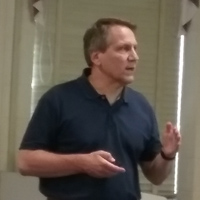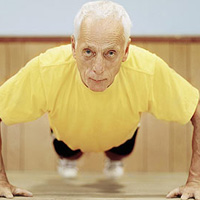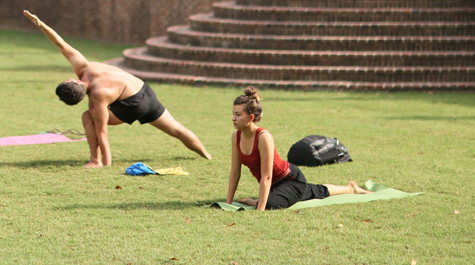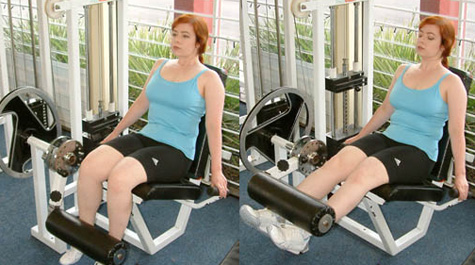Deschenes examines Americans' disconnect with health, exercise
There are four things every American should have at the very least a passing interest in achieving, said Mike Deschenes, William & Mary professor of kinesiology and health sciences and chair of the department.
Those would be cardiovascular fitness, muscular fitness, flexibility and body composition.
In other words, the four cornerstones for health-related fitness.
Sadly and inexplicably, he added, very few people do.
Deschenes, who is teaching a course this summer titled Scientific Principles of Exercise Prescription, pointed to a Time magazine story that reported that only about 20 percent of Americans get the recommended 150 minutes of strength and cardiovascular physical activity per week. More than half of baby boomers report doing no exercise whatsoever; in general 80.2 million Americans over the age of six report being completely inactive.
“When we talk about those minimal standards to improve your health, that’s a total of 30 minutes a day – but you can break them up into three 10-minute sessions,” Deschenes said, his frustration evident. “You don’t have to put on your (gym shoes), your gym shorts. If you walk your dog, it’s going to be pretty easy to get 30 minutes a day. You walk to the corner to pick up the bus; that’s easy enough. You walk up and down the aisles of the grocery store, do yard work, mow the lawn. They all count.”
According to the Centers for Disease Control and Prevention, 40.2 percent of adults 40-59 years old are obese, as are 37 percent of adults 60 or older. Obesity-related illnesses, including chronic disease, diabetes, disability and death carry an annual cost of $190.2 billion.
“We’re now seeing kids develop what used to be ‘grandma-type’ diabetes,” Deschenes said. “How are we going to manage that for 70 or 80 years? We’ve now got a nine-year-old son or daughter who’s obese and has Type 2 diabetes.”
Deschenes emphasized what people have been told for years: The only way to change one’s body composition – lose weight – is through a combination of diet and exercise.
“Diet is the best thing,” he said. “Several years ago I was at a conference and the U.S. Surgeon General was there. She said the two most important things you can do to improve and/or maintain your health are watching your diet and getting some exercise. As far as losing weight, dieting is the most effective action you can take. And those things are completely within your control.
“Then she said, ‘and, of course, that’s the scary part. The drawback is that it’s within your control. You can’t just take a pill for it. You actually have to do it.'”
How much exercise is enough to improve one’s health? Deschenes said that if a workout combines aerobic and weight training, three sessions a week should suffice. If one is alternating aerobic and weight training, they should exercise five times a week.
The one thing the person looking to get back in shape may need to exercise most?
Patience.
In what Deschenes calls the “initiation stage,” a person should spend three to six weeks in low-intensity exercise, 15 to 20 minutes initially before increasing to 40 minutes. At first, limit your frequency to three times a week before gradually increasing to five times a week – assuming there's no soreness.
“Give them something they can do,” Deschenes told the class. “Give them something they can succeed at so they can feel good about themselves. Otherwise, not only is there physical damage, but they start saying to themselves, ‘No way I’m doing that to myself again.’”
Following the initiation stage is the improvement stage, 20 to 22 weeks of very gradual increases in exercise duration and intensity – no more than five to 10 minutes a session on a weekly basis.
And, finally, there is the maintenance stage, in which other forms of exercise can be used to replace some of the things done in the initiation and improvement stages. If a person’s goal is general health, they may even be able to decrease both frequency and the volume of exercise as long as the intensity is maintained without any noticeable effects.
Deschenes emphasized that as much as people believe they are able to design an effective program on their own, it’s in their best interest to consult with a professional trainer.
“How many times have we seen a man who was a high school jock, hasn’t done anything for 20 years, who says, ‘OK, I’ve had it; going to get myself fit again,’” Deschenes said. “What do they think they have to do? Just weight training. That’s good but you have to have in there, too, especially if you’re middle aged, have hypertension. You just can’t start lifting weights again. You need balance.”
Weight training leads to improved muscular fitness, one of Deschenes’s cornerstones. Not only does daily living, like climbing stairs, become less stressful, there are benefits most people are unaware of, he said.
- It lowers the risk of falling, the thing assisted-living and nursing home workers say they fear most among their charges.
- It leads to fewer heart attacks and strokes.
- It lowers the risk of non-fatal diseases, like arthritis.
- It improves body composition.
- It allows for better management of blood sugar and blood pressure.
- It improves bone mass and strength.
- It lowers the chances of osteoarthritis.
And, yet, so few people are willing to devote the time and effort. One of Deschenes’s students recently hypothesized that despite numerous media campaigns, maybe people haven’t received the information.
“We’re missing that final piece,” Deschenes said. “We know how much. We know how often. We know how hard. We know what type. We know the health benefits that will prevent these types of cancers, this disease, that disease.
“I see it a lot, but I’m in the field. I’ll notice it if I go through The Washington Post and see stories. I’ll read them. But most people aren’t going to read them. Maybe the people who need it the most still aren’t getting the message. Frankly, I don’t know what to do about that.”
 Skip to main content
Skip to main content



